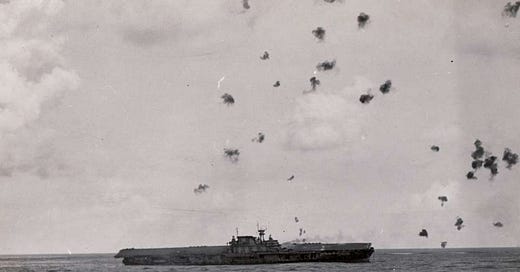The Eternally, Irreplaceably Vulnerable: Aircraft Carrier at War - with Dr. John T. Kuehn on Midrats
the feature and bug of being valuable
The vulnerability of aircraft carriers is nothing new. They are vulnerable not just because of how they are designed - really just a thin hulled ship full of fuel and explosives - but because of what they do.
At peace and at war, there is no other platform that can project power and national will on a global scale at sea than an aircraft carrier. As such, everyone either wants one, or wants to sink one - or both.
While many people think of the Pacific wars of WWII, Korea, and Vietnam as places where the US Navy's aircraft carriers could operate at will and dominate everything, that really was not the case until late 1944.
The reality was quite different before then. Proper use of carriers was mostly about husbanding carriers’s limited resources while still getting max value out of them.
That will be the topic of today’s podcast with returning guest Dr. John T. Kuehn.
John is Professor of Military History at the Army Command and General Staff College. He served in the US Navy as a naval flight officer flying in EP-3s and ES-3s, retiring in 2004. He has authored or co-authored seven books and was awarded a Vandevort Prize from the Society for Military History in 2023 for his article “Zumwalt, Holloway, and the Soviet Navy Threat Leadership in a Time of Strategic, Social, and Cultural Change.”
His latest book from is Strategy in Crisis (Naval Institute, 2023).
You can listen here or at the below.





Perhaps the Commander is not aware that USN CVN's are armored - about on the scale of a WW1 era battleship? [The amphib LHA/LHDs that are sort of second class carriers are not]. Or perhaps by vulnerable he simply means they are too big to hide in this era of OTH radar, imagery, and, operationally, because they tend to transmit so many signals so much of the time any enemy with an intercept receiver within upwards of a thousand nautical miles knows exactly where they are? I used to track the first USS Enterprise AND identify her easily because only she and the CVN Long Beach were fitted with the SPS-32/33 radar system which was turned on radiating powerful, easily identifiable radar beams.
The Japanese learned their value the hard way when they went all-in at Midway in 1942, consolidating their most valuable asset in one location so could sink all four carriers. That was nice of them. That single event made it absolutely certain Japan would lose the war, and they knew it.